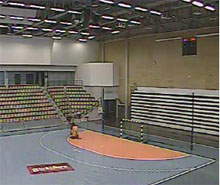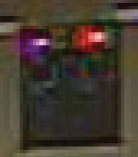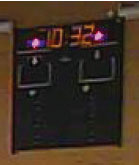In the world of camcorders, a product that supports eighteen times the zoom may not be inferior in quality to a product that supports thirty-six times the zoom. Moreover, a high-resolution camera that supports eighteen-fold zoom can receive images that are just as or more useful for security than an analog camera with a standard resolution but twice as powerful zoom.
Compare the images below. Figure 1 shows an image magnified 36 times from a 4CIF camera with a resolution of 704 x 480 pixels. Figure 3 shows an image magnified 18 times with a FullHD 1080p PTZ camera with a resolution of 1920 x 1080 pixels.


4CIF resolution camera. Zoomed image.


IP-camera with 720p resolution. Zoomed image.
The result achieved is practically the same: the name of the newspaper, for example, is readable. However, an HDTV camera provides the same detail with just half the power of a conventional resolution camera zoom.
Equally important, the HDTV network camera has a wider view (16: 9), which makes it possible to monitor a larger area without compromising on detail. In the image from the 4CIF camera (Figure 1), only one person can be seen, while in the image from the IP camera, the operator is able to see more than one person and at the same time examine small details, such as the text of the newspaper. That is, while the level of detail is the same, the capabilities and advantages of the IP camera are still greater, which affects the effectiveness of the security system.
But how can a camera with eighteen times zoom provide the same level of detail as with thirty-six times?
The assumption is widespread that the higher the magnification of the lens, the better the ability to sharpen details. But this is not always true, as shown above.
Magnifying lenses are a series of lenses with a variable focus. A longer focus length is a larger increase, but also a proportional decrease in the viewing angle.
Lens magnification is usually expressed as the ratio between the longest and shortest supported focus lengths. For example, a lens with a focus length of 50 to 200 mm refers to lenses with a four-fold increase. Two different lenses with the same magnification power can produce different images, since their focus length and magnification ability can be different, while the ratio between the longest and shortest supported focus length is the same. Moreover, a lens with a higher ratio does not necessarily have a higher magnification ability. For example, a lens with a range of 15 to 150 mm (tenfold zoom) will actually have weaker magnification power than a lens with a fourfold magnification and a range of 50 to 200 mm.
Speed dome IP-камера Geovision GV-SD200 c 18х оптическим зумом.


4CIF resolution camera. Zoomed image.


IP-camera with 720p resolution. Zoomed image.
The viewing width in both cases is almost identical. However, higher image quality, excellent detail and impeccable color accuracy of the IP camera are obvious. Compare the fragments of the image in figures 6 and 8. The numbers on the scoreboard are easily distinguishable on the HDTV image, while they can hardly be distinguished on the image from the 4CIF camera.
Image data demonstrates that in the absence of zoom, a digital PTZ camera can capture more details. In fact, an HDTV camera has almost twice as many pixels at the same viewing width.
Other factors affecting image quality.
Image quality is not determined only by the resolution height. Other elements such as resolution and by itself the quality of the lens. The properties and quality of glass in the dome cover are also quite important. Another significant factor is the presence of streaming video with a full frame rate so that any activity in the field of view and fast moving objects can be seen and captured. A network PTZ IP camera that is compliant with SMPTE standards in resolution, frame rate, and color fullness provides superb image detail.
Therefore, we made sure that the Speed dome ip-camera is able to satisfy the demands and requirements of security systems, having only half the possible zoom of an analog PTZ camera.
